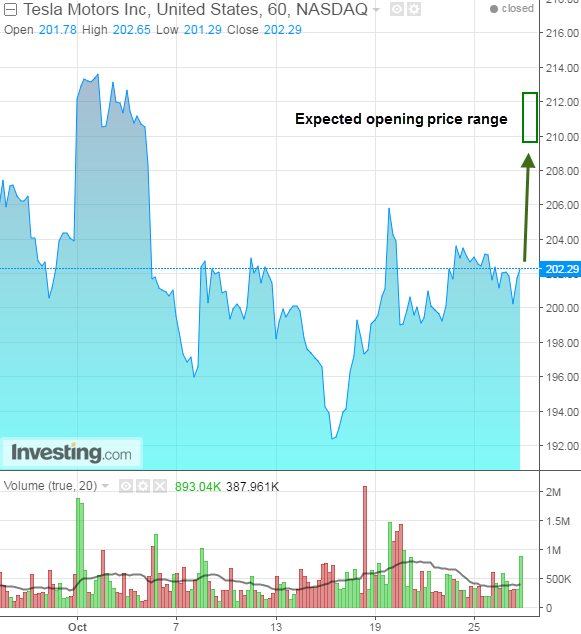Clement Thibault is a market analyst for Investing.com

Yesterday, Tesla (NASDAQ:TSLA) reported positive earnings of $0.14 per share on $2.30 billion revenue, which caused the stock to jump more than 4% overnight. While the results were a positive surprise since analysts as a whole expected the company to report a loss, one has to wonder if Tesla is really reaching profitability. Or could this simply be a one-time event that may not happen again soon?
First, a quick look at the numbers. Yesterday, Tesla reported a profit for only the second time in its history, repeating its Q1 2013 accomplishment. In addition, it was the highest revenue number the company has ever reported during any quarter, easily doubling its Q3 2015 revenues. Nevertheless, it's worth noting that Tesla still missed revenue expectations by 50 million; analysts were expecting $2.35 billion.
As for profits, on August 29 of this year, Musk sent an e-mail to employees, urging them to "trim any cost that isn't critical" in order to achieve profitability before a year of anticipated massive capital outlay ahead of the ramp up of Model 3 production, which will inevitably push Tesla well into the red yet again. From that letter, we discern that this quarter isn't a result of regular, continuous operational efficiencies, but rather that Tesla—and Musk—fully intended to do everything in their power to be able to show a positive result.
Digging a little deeper into the numbers shows that the company didn't entirely rely on a productivity boost by its employees either. Rather, in what appears to be a savvy if calculating move, it decided to actively—albeit legally—reshape its financial bottom line for the quarter.
In Q3, Tesla sold over $138 million worth of Zero Emission Vehicle (ZEV) credits to other automakers which undoubtedly provided a one-time boost to the company's reported profits. At the same time, it seems that Tesla also put a stronger emphasis on reducing capital expenditures for Q3, since the $247 million spent on Capex is lower than last year's $392 million as well as last quarter's $294 million. According to the company's guidance, the expected Capex number for Q4 will be bigger than all Capex outlay over the previous three quarters.
Yesterday's results are immensely important to Tesla, which in the near future intends to raise additional capital and thus needs shareholders to approve a merger deal with Musk's SolarCity (NASDAQ:SCTY) that has been reviled by market analysts. This wouldn't be the first time that Tesla is taking steps to make itself look good when it needs to.
On May 18th this year, Tesla sold more than $2 billion in shares via a secondary share offering, priced at $215 per share. What the public didn't know is that a fatal crash involving Tesla's autopilot system occurred on May 7th and was never disclosed to the public. When approached for comment by Fortune last July, Musk replied that the crash wasn't disclosed to the public because it "is not material to the value of Tesla."
For investors, it’s crucial to treat Tesla just like any other company. Right now it appears that based on Musk's highly appealing, futuristic vision, along with his vaunted charisma, investors are willing to turn a blind eye to Tesla's real prospects, while naively ignoring the metrics that would matter for any other publicly traded company.
Over both the short and longer term, significant questions surrounding Tesla persist, namely about the completion of its Gigafactory and its ability to deliver half a million quality cars annually, less than two years from now.
